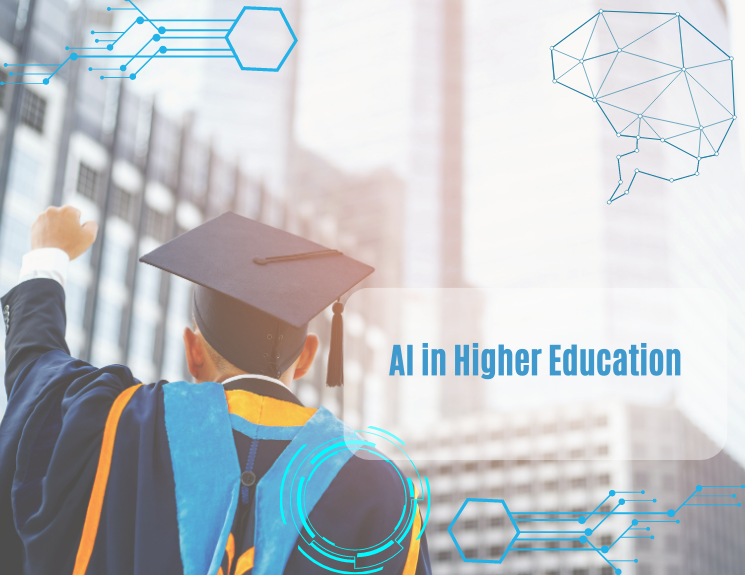AI technologies will significantly impact higher education by disrupting the traditional learning approach. Its widespread adoption in universities and colleges opens numerous opportunities as well as presents substantial threats.
One of the major concerns about the use of ai in higher education is whether it is a form of cheating when students use it to create and submit academic essays and homework.
However, artificial intelligence in higher education opens the door to numerous opportunities for positive outcomes for both learners and professionals. For instance, most college and university students admit how they grapple with writing compelling essays, which results in poor performances.
AI allows them to learn important aspects and features that help them in becoming proficient essay writers. Therefore, despite the raging opposition, embracing AI in institutions of higher learning is inevitable.
The 3 Key Benefits of Using AI in Higher Education

-
Streamline the enrolment process
One of the most outstanding benefits of embracing AI in colleges and universities is simplifying the student enrolment process. In the modern education environment, institutions are finding it increasingly challenging to convince students to enroll.
Both private and public entities have continuously innovated new approaches to ensure their selection process guarantees they attract and persuade the right students to join their institutions. The approaches have not always proved to be successful.
However, this is poised to change since the use of ai in education will help universities and colleges identify and persuade prospective students to enroll.
The new technology allows learning institutions to provide applicants with personalized information and responses to queries, making the application process easier and more convenient. Moreover, AI will help recruitment officers to identify learners who are genuinely interested in joining their institutions. Hence prioritizing them.
-
Enhance student retention rates and promote chances of graduating
One of the main causes of students dropping out of colleges and universities is pursuing the wrong courses. AI will help institutions to match students with courses that align with their capabilities and interests. Additionally, through AI, universities, and colleges will easily predict other factors that could lead to student dropout, enabling them to provide timely interventions.
For instance, AI tools could be used to help learners overcome common and unforeseen challenges that could discourage them from completing their courses. For instance, learners who would give up due to the complexity of the subject they are pursuing could utilize AI platforms for personalized training, which will help them to conceptualize important course concepts, making it easy to sail through.
-
Create opportunities for personalized teaching and self-training
Another important highlight of the positives of AI is that it provides numerous opportunities for professors to offer personalized teachings to students. Unlike in the traditional classroom setting, professors can easily identify the areas of student weaknesses and prepare resourceful materials that will help the students to improve their performances. Students could also utilize AI during their free time to learn important concepts that may not have been understood in class.
More importantly, AI tools help students to write high-quality papers by studying the features that define a top-notch essay from the comfort of their homes. Learners who struggle to write compelling essays have embraced AI writing tools as their new source of competitiveness.
Instructors and learners can generate educational materials that specifically address a student’s unique needs. While it would reduce interpersonal interactions between the instructor and the learner, it results in improved academic performance.
Why Students Use AI Chatbot in Higher Education

- Time-saving: An AI chatbot is fast and convenient, which helps students to save massive time in completing their assignments. If, for instance, you are conducting extensive scientific research, you could use AI chatbots to collect credible and reputable external sources. It will save you massive time, allowing you to dedicate your efforts to actual writing.
- Easily accessible and affordable: AI chatbots are easily accessible and affordable, making them popular among students. Learners who need extra assistance with their academic projects and scientific papers can hire a research paper writer at CustomWritings, a reputable service among college students who can easily access and have their research papers written from scratch.
- Overcome writer’s block: Students utilize chatbots to overcome writer’s block. Commonly, most writers find it challenging to come up with ideas or arguments to develop their essays. AI tools will help you overcome similar challenges by helping you brainstorm relevant ideas for your essay prompt.
- Facilitate learning at one’s pace: One of the popular current uses of AI chatbots in higher education is self-paced learning. Students can plan to study important concepts at their convenience. For instance, learners could practice what they learned in class to ensure they completely master the concepts.
The Negative Side of Artificial Intelligence in Higher Education
While AI chatbots have numerous benefits they have significant downsides that should be considered to ensure they are appropriately used for maximum benefits. Here are the most pronounced negative impacts of AI in higher education.
- Students may over-rely on technology: One noticeable impact of artificial intelligence is that students may become wholly dependent on the use of technology in answering essay prompts. This may impact the quality of education they get and limit their problem-solving and critical-thinking skills.
- Negatively impact interpersonal connection: Although AI presents numerous opportunities to streamline the learning and teaching experience, it results in a significant decline in human interaction. In education at all stages, human interaction is necessary for harnessing social skills. Additionally, the more interaction with peers and instructors, the more one learns.
- May result in skewed opinions or prone to inaccuracy: Since AI tools provide the information they are trained, they might provide inaccurate data or a biased opinion on a given subject. In case the chatbots contain unverifiable information that is biased and inaccurate, it would be difficult for students to unlearn.
- Confidentiality concerns: There are no privacy and confidentiality guarantees while using chatbots. In the unfortunate event that the chatbot is hacked, you will be exposed to data breaches.
Final Thought
Since AI technology is here to stay and is deemed to disrupt the education system, stakeholders in higher education must ensure its future applications align with the anticipated outcomes. Institutions should have strong guidelines that help instructors, staff, and learners on maximizing the benefits of AI in the classroom.
Its use should, however, improve the quality of education. For instance, it should help learners to create adequate time to develop the necessary skills that they would transition to the workplace. Institutions should create awareness of the numerous opportunities created by AI technology.

